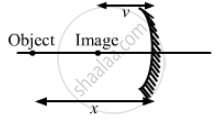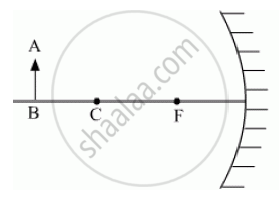Advertisements
Advertisements
प्रश्न
A particle is moving at a constant speed V from a large distance towards a concave mirror of radius R along its principal axis. Find the speed of the image formed by the mirror as a function of the distance x of the particle from the mirror.
उत्तर
Given,
Radius of the concave mirror is R
Therefore focal length of the mirror,
\[f = \frac{R}{2}\]
Velocity of the particle, \[V = \frac{dx}{dt}\]
Object distance, u = −x
Using mirror equation,
`1/v + 1/u = 1/f`
On putting the respective values we get,
`1/v + 1/-x= -2/R`
⇒ `1/v = -2/R + 1/x = ( R- 2x )/ ( Rx )`
∴ v = `(Rx) /( R - 2x`
Velocity of the image is given by V1
`V^1= (dv)/dt = d/dt [(Rx)/ R-2x]`
`= [d/dx (Rx ) (R -2x)]- [d/dx ( R-2x )(Rx)]/ (R - 2x)^2`
`= R [ (dx/dt) (R - 2x )] - [ 2dx/dt x] /( R -2x )^2`
`=(R[(V) (R-2x)] - [ 2Vxx 0] )/( R-2x)^2`
`= VR^2/(2x -R )^2`
APPEARS IN
संबंधित प्रश्न
An object is placed 15 cm in front of a convex lens of focal length 10 cm. Find the nature and position of the image formed. Where should a concave mirror of radius of curvature 20 cm be placed so that the final image is formed at the position of the object itself?
A mobile phone lies along the principal axis of a concave mirror. Show, with the help of a suitable diagram, the formation of its image. Explain why magnification is not uniform.
A convex lens of focal length 20 cm is placed coaxially with a concave mirror of focal length 10 cm at a distance of 50 cm apart from each other. A beam of light coming parallel to the principal axis is incident on the convex lens. Find the position of the final image formed by this combination. Draw the ray diagram showing the formation of the image
A convex lens of focal length 20 cm is placed coaxially with a convex mirror of radius of curvature 20 cm. The two are kept 15 cm apart. A point object is placed 40 cm in front of the convex lens. Find the position of the image formed by this combination. Draw the ray diagram showing the image formation.
Draw a ray diagram to show image formation when the concave mirror produces a real, inverted and magnified image of the object.
A convex lens of focal length 20 cm is placed coaxially in contact with a concave lens of focal length 25 cm. Determine the power of the combination. Will the system be converging or diverging in nature?
A convex lens of focal length 25 cm is placed coaxially in contact with a concave lens of focal length 20 cm. Determine the power of the combination. Will the system be converging or diverging in nature?
A convex lens of focal length f1 is kept in contact with a concave lens of focal length f2. Find the focal length of the combination.
An object AB is kept in front of a concave mirror as shown in the figure.

(i) Complete the ray diagram showing the image formation of the object.
(ii) How will the position and intensity of the image be affected if the lower half of the mirror’s reflecting surface is painted black?
Use Huygens’ geometrical construction to show the behavior of a plane wavefront.
(i) Passing through a biconvex lens;
(ii) Reflecting by a concave mirror
A particle goes in a circle of radius 2.0 cm. A concave mirror of focal length 20 cm is placed with its principal axis passing through the centre of the circle and perpendicular to its plane. The distance between the pole of the mirror and the centre of the circle is 30 cm. Calculate the radius of the circle formed by the image.
A concave mirror of radius R is kept on a horizontal table (See figure). Water (refractive index = μ) is poured into it up to a height h. Where should an object be placed so that its image is formed on itself?

A hemispherical portion of the surface of a solid glass sphere (μ = 1.5) of radius r is silvered to make the inner side reflecting. An object is placed on the axis of the hemisphere at a distance 3r from the centre of the sphere. The light from the object is refracted at the unsilvered part, then reflected from the silvered part and again refracted at the unsilvered part. Locate the final image formed.
A gun of mass M fires a bullet of mass m with a horizontal speed V. The gun is fitted with a concave mirror of focal length f facing towards the receding bullet. Find the speed of separation of the bullet and the image just after the gun was fired.
In the case of a concave mirror of focal length f , when an object is kept between f and 2 f , show that its image is formed beyond 2 f .
